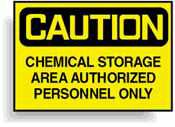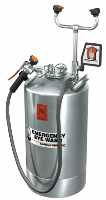 |
 |
| MSDS Topics |
Free Sites | FAQ's | Regulations | Glossary | Software | Suppliers |
| Books | Forum | Poll | Fun stuff | Quiz | Store | |
| MSDS and safety supplies | Search ALL our MSDS info | |||||
 | |||
 |
 |
 |
|
| Title: 02/02/1994 - Hazard determination for carcinogenic compounds. | |
| Record Type: Interpretation | Standard Number: 1910.1200 |
February 2, 1994
Angela M. Mack
Product Safety Information Coordinator
UOP
25 East Algonquin Road
Des Plaines, Illinois 60017-2000
Dear Ms. Mack:
Thank you for your letter of October 5 concerning the requirements under the Occupational Safety and Health Administration's (OSHA) Hazard Communication Standard (HCS), 29 CFR 1910.1200. Specifically, you inquired about section 1910.1200(d)(4)(ii) regarding hazard determination for carcinogenic compounds, in particular cobalt phthalocyanine sulfonate compounds.
Your question has been addressed in OSHA's compliance directive, Inspection Procedures for the Hazard Communication Standard (CPL 2-2.38C). This directive states the following:
| Under the Hazard Communication Standard chemical manufacturers have the responsibility to "identify and consider" all available scientific evidence for the chemicals they produce or import to determine if they are hazardous. In general, if an IARC monograph does not address a specific chemical or group of chemicals, the results of the monograph would not apply. However, it is your duty as the chemical manufacturer to evaluate all other scientific evidence and available studies to determine if any other evidence exists that may indicate a carcinogenic health hazard is associated with exposure to the cobalt phthalocyanine sulfonate compounds. The fact that your product was not addressed in the IARC monograph does not relieve you of the mandate to look elsewhere for other statistically significant evidence that carcinogenic or other health effects may result from employee exposure to cobalt phthalocyanine sulfonate compounds. |  Encourage proper work habits with safety signs, labels and training from Safety Emporium. |
We hope this information is helpful. If you have any further questions please contact us at (202) 219-8036.
Sincerely,
Ruth McCully, Director
Office of Health Compliance Assistance
October 7, 1993
U.S. Department of Labor
Occupational Safety and Health Administration
200 Constitution Avenue, N.W.
Washington, DC 20210
Attention: Jennifer Silk
Re: OSHA Hazard Communication Standard
Dear Ms. Silk:
We would like to obtain clarification of the OSHA Hazard Communication Standard, particularly Section 1910.1200(d)(4)(ii) regarding hazard determination for carcinogenic compounds. The standard states:
...
(ii) International Agency for Research on Cancer (IARC) Monographs.
We have a group of products that contain cobalt phthalocyanine sulfonate compounds. The 52 Volume of the IARC Monograph series includes an evaluation of cobalt and cobalt compounds. The Monograph states at page 363 that agents considered in it include (a) metallic cobalt, (b) cobalt alloys, and (c) cobalt compounds. It specifically then says: "Organic cobalt-containing agents (e.g. vitamin b(12)) are not covered comprehensively in the monograph." This infers that IARC was treating organic cobalt-containing compounds differently than inorganic cobalt-containing compounds, and was excluding such compounds from the general evaluation of cobalt and cobalt compounds.
This differentiation is further shown in the data present in the Monograph. Of the nine specific chemicals evaluated by IARC, two of them show sufficient animal evidence for carcinogenicity (cobalt metal powder and cobalt [II] oxide); three showed limited evidence and the remainder showed insufficient evidence. Notably, the two organic cobalt-containing compounds, cobalt acetate and cobalt naphthenate, showed insufficient evidence of carcinogenicity in experimental animals. Though the overall evaluation on page 450 of the Monograph states that cobalt and cobalt-compounds are possibly carcinogenic to humans (Group 2B), the specific evaluations on page 449 of the Monograph say: "There is inadequate evidence for the carcinogenicity of ... cobalt naphthenate and cobalt [III] acetate in experimental animals."
|
Based on our evaluation of the information presented in the IARC Monograph, there is no evidence to show that organic cobalt-containing compounds present a potential carcinogenic risk. Our products contain cobalt phthalocyanine sulfonate compounds, which were not specifically analyzed in the IARC Monograph. Nevertheless, cobalt phthalocyanine sulfonate is an organic cobalt-containing compound like cobalt naphthenate and cobalt [III] acetate, which were examined in the IARC Monograph. In terms of the OSHA Hazard Communication Standard, can our hazard evaluation be based on the specific information presented within the IARC Monograph, or are we bound by the overall evaluation of cobalt and cobalt compounds. In other words, must we state that products, which contain cobalt phthalocyanine, are considered by IARC to be possibly carcinogenic to humans (Group 2B), when specific information in the IARC Monograph says that there is inadequate evidence for the carcinogenicity of organic cobalt-containing compounds. |
 Working at a remote location? Portable eye wash units from Safety Emporium can help meet OSHA requirements. |
Your advice on this question will be greatly appreciated.
Very truly yours,
Angela M. Mack
Product Safety Information Coordinator
The official, public domain, OSHA version of this document is available at http://www.osha.gov/pls/oshaweb/owadisp.show_document?p_table=INTERPRETATIONS&p_id=21390&p_text_version=FALSE